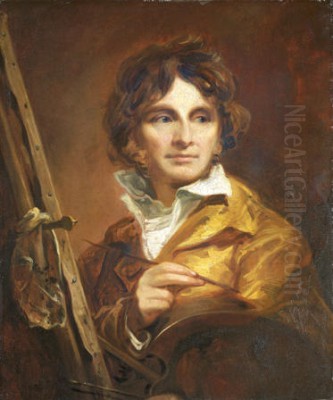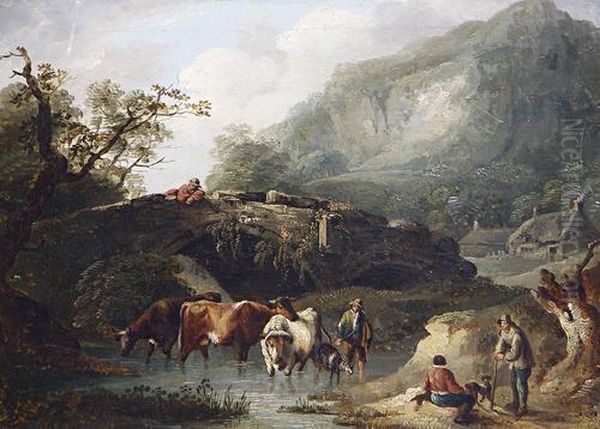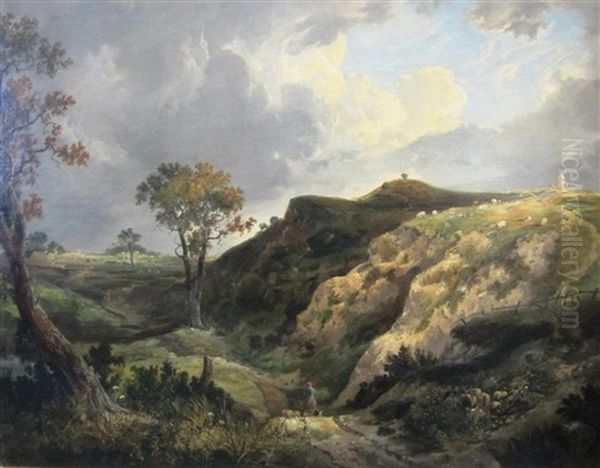
Thomas Barker (1769-1847) was a notable British artist, primarily celebrated for his evocative landscape paintings and depictions of rural life. Born near Pontypool in Monmouthshire, Wales, he spent the majority of his prolific career in Bath, England. This long association with the city earned him the affectionate moniker "Barker of Bath," distinguishing him within the annals of British art history.
His artistic journey began with a period of self-teaching, reportedly involving the imitation of works by Old Masters. Early sources suggest an initial focus on copying, a common practice for aspiring artists of the era seeking to understand technique and composition. This foundational period helped shape his technical abilities before he developed a more distinct personal style.
Early Life and Patronage in Bath
Relocating to Bath at a young age, Barker's burgeoning talent soon attracted attention. A crucial figure in his early development was the wealthy coachbuilder and art enthusiast, Charles Spackman. Recognizing Barker's potential, Spackman became his patron around 1785, providing financial support and guidance. This patronage was instrumental, allowing Barker the freedom to hone his skills without immediate commercial pressures.
Under Spackman's wing, Barker continued to study and paint. Their relationship was evidently close, extending beyond simple patronage to mentorship. Evidence of this connection includes a double portrait they reportedly painted together in 1789, showcasing their collaborative spirit during Barker's formative years. Spackman's support enabled Barker to travel to Italy for further study from 1790 to 1794, a vital experience for many British artists seeking exposure to classical and Renaissance art.
Artistic Style and Influences
Thomas Barker's artistic output is firmly rooted in the British landscape tradition. His style is often associated with the Early Landscape School, showing affinities with the work of prominent predecessors and contemporaries. He particularly admired, and was significantly influenced by, the works of Thomas Gainsborough (1727-1788), whose fluid brushwork and sensitive portrayal of the English countryside resonated deeply with Barker's own sensibilities.

Comparisons are also frequently drawn with George Morland (1763-1804), another painter celebrated for his rustic scenes and depictions of rural labour and leisure. Like Morland, Barker often focused on the picturesque aspects of country life, capturing figures within natural settings. His paintings typically feature free, expressive brushwork, a keen eye for atmospheric effects, and a palette that emphasized the natural charm and subtle colours of the landscape.
Further influences can be traced to 17th-century Dutch landscape painters, particularly Meindert Hobbema (1638-1709), whose detailed yet atmospheric woodland scenes likely informed Barker's approach to rendering trees and natural textures. Barker skillfully synthesized these influences, combining the naturalism of the Dutch tradition with the more painterly qualities favoured by British artists like Gainsborough, ultimately forging a style recognized for its sensitivity to nature.
While some critics occasionally noted perceived weaknesses in his draughtsmanship compared to his contemporaries, Barker's innate talent as a painter and his genuine feeling for his subjects were widely acknowledged. His ability to capture the mood and character of the British landscape and its inhabitants secured his reputation.
Representative Works and Themes
Throughout his long career, Thomas Barker produced a substantial body of work, primarily in oil but also exploring other media like lithography. One of his most famous early works, often cited as demonstrating Gainsborough's influence, is "The Woodman and His Dog in a Storm." This piece exemplifies his interest in dramatic natural effects and the relationship between humanity and the forces of nature.
A significant contribution to printmaking was his collection of lithographs published in 1813, titled "Forty Lithographic Impressions of Rustic Figures from Studies from Nature" (also referred to as "Impressions of Rustic Figures after Nature"). This series was among the earliest successful artistic uses of lithography in Britain, showcasing Barker's skill in the relatively new medium and his continued focus on observing and recording rural characters and scenes directly from life.
Later in his career, Barker undertook ambitious projects, including a large fresco titled "The Massacre of the Turks at Scio." Measuring an impressive 30 by 12 feet, this work was painted directly onto the wall of his home, Sion Hill, in Bath in April 1842. It demonstrated his capacity for large-scale historical or contemporary subjects, although he remained best known for his landscapes. A study for this fresco is held in the collection of the Victoria Art Gallery in Bath.

Other notable works include numerous "Pastoral Landscapes," which capture idyllic scenes often featuring shepherds, livestock, and rolling hills under expressive skies. Paintings like "Shepherd Boy Piping" (late 18th/early 19th century) focus on solitary figures within the landscape, evoking a sense of rustic tranquility. "Clover Field with Figures," now in the Tate collection, is another example of his characteristic blend of landscape and genre elements. Some works, like one described as depicting workers, gentry, riders, and dogs near a wood (potentially titled "Symptopu" according to one source, though the title is uncertain), suggest an element of social observation within his rural scenes.
Relationships with Contemporaries and Reputation
Thomas Barker operated within a vibrant British art scene that included major figures like J.M.W. Turner (1775-1851) and John Constable (1776-1837), who were revolutionizing landscape painting. While Barker's style remained more aligned with the earlier generation of Gainsborough and perhaps Richard Wilson (1714-1782), he maintained a successful career, particularly popular in Bath and its surrounding regions.
His close connection to Thomas Gainsborough's style, however, became a recurring point of discussion and sometimes controversy. Barker's skill in emulating Gainsborough's manner led to frequent comparisons, and occasionally his works were mistaken for, or even intentionally passed off as, those of the more famous master. This led to criticism from some quarters that Barker was merely an imitator, lacking true originality.
Despite these criticisms, Barker achieved considerable contemporary recognition and commercial success. He exhibited regularly at institutions like the Royal Academy and the British Institution. His patron, Charles Spackman, played a key role early on, but Barker sustained his career long after this initial support. He was seen as a significant figure in the Bath art world, influencing local taste and artists.
Furthermore, artistic talent ran in the family. His younger brother, Benjamin Barker (1776-1838), was also a respected landscape painter, often exhibiting alongside Thomas. His son, Thomas Jones Barker (1815-1882), followed in his father's footsteps, becoming a successful painter known particularly for historical and military scenes, achieving recognition beyond Bath, notably in London and Paris. This familial connection highlights the artistic environment in which Thomas Barker lived and worked. Other contemporaries active during parts of his career included portraitists like Sir Thomas Lawrence (1769-1830) and painters exploring different themes, such as Joseph Wright of Derby (1734-1797).
Lithography and Innovation
Beyond his oil paintings, Barker's engagement with lithography marks him as an early adopter of this printmaking technique in Britain. Introduced commercially around the turn of the 19th century, lithography offered artists new possibilities for reproducing drawings directly and achieving tonal effects. Barker's 1813 publication, "Impressions of Rustic Figures after Nature," was a pioneering effort that demonstrated the medium's potential for capturing the immediacy of sketches and studies.
This venture into lithography shows Barker's willingness to explore new artistic avenues. The forty plates depicted various rural characters – farmers, labourers, women, and children – observed with sympathy and an eye for characteristic detail. The series proved popular and helped to establish lithography as a viable artistic medium in the country, paving the way for later artists like Richard Parkes Bonington (1802-1828) and James Duffield Harding (1798-1863).
His work in this medium reinforced his reputation as an artist deeply engaged with the observation of everyday life, particularly in rural settings. It provided a means to disseminate his images more widely than unique oil paintings allowed, contributing to his popularity and influence during his lifetime.
The Sion Hill Fresco
The creation of the large fresco, "The Massacre of the Turks at Scio," in his own home in Bath represents another interesting facet of Barker's career. Fresco painting (buon fresco), involving painting on wet plaster, was relatively uncommon in Britain compared to Italy. Undertaking such a large and technically demanding work in this medium in the 1840s speaks to Barker's ambition and perhaps a desire to engage with grand historical themes, possibly inspired by contemporary events or the works of continental artists like Eugène Delacroix (1798-1863), whose own famous painting of the Chios massacre was exhibited in 1824.
While the fresco itself is no longer in situ, studies and contemporary accounts attest to its existence and scale. It depicted a dramatic and violent scene from the Greek War of Independence, a subject that captured public imagination across Europe. This work stands apart from his typical landscapes and rustic genre scenes, showcasing his versatility and engagement with broader historical narratives, even late in his career.
Legacy and Collections
Thomas Barker died in Bath on December 11, 1847, leaving behind a significant legacy as a painter of the British landscape and rural life. While perhaps overshadowed nationally by giants like Constable and Turner, he remains a key figure in the history of art in Bath and the West Country. His work bridged the picturesque tradition of the late 18th century with the developing naturalism of the 19th century.
His reputation rests on his sensitive portrayal of nature, his sympathetic rendering of rustic figures, and his contribution to the popularization of landscape painting. The persistent debate about his originality versus his imitation of Gainsborough highlights the complexities of artistic influence and reputation-building in the period. Nevertheless, his best works possess a distinct charm and authenticity derived from his deep connection to the landscapes and people he depicted.
Today, Thomas Barker's paintings and prints can be found in numerous public collections. The Victoria Art Gallery in Bath holds a particularly strong collection, reflecting his status as the city's most famous resident artist of his time. Works are also held by the Tate Britain in London, the British Museum, and various regional galleries throughout the UK. His art continues to be appreciated for its contribution to the British landscape tradition and its evocative portrayal of a bygone rural world.
Disambiguation
It is important to note that the name "Thomas Barker" belongs to several distinct historical figures. Besides the painter Thomas Barker of Bath (1769-1847), there was Thomas Barker (1722-1809), a Rutland squire known for his meteorological diaries; Thomas Barker (1713-1789), a lawyer and political figure in North Carolina; Thomas Barker (1835-1875), an educator and philanthropist in Sydney, Australia; and Thomas Barker (1803-1880), another scholar interested in natural history and meteorology. Furthermore, the historian Henry Thomas Buckle (1821-1862) is sometimes confused due to the similarity in names. This article specifically concerns Thomas Barker, the British painter active primarily in Bath.